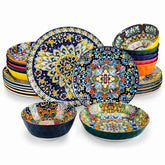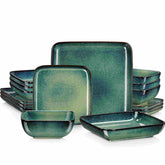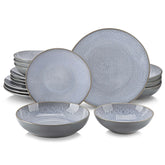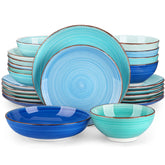Exploring the Crafting Techniques Used to Create Colorful Stoneware Dinnerware Sets
Stoneware dinnerware sets have been a staple in kitchens for centuries, and for good reason. Stoneware is durable, versatile, and can be crafted into a wide variety of shapes and designs. One of the most appealing aspects of stoneware tableware is the endless variety of colors and patterns that can be achieved through different crafting techniques. In this blog post, we will explore some of the most popular crafting techniques used to create colorful stoneware dinnerware sets.
Wheel-Throwing
One of the most traditional and popular techniques used to create stoneware tableware is wheel-throwing. This technique involves using a potter's wheel to shape the clay into the desired form. The process begins with a ball of clay that is centered on the wheel and then shaped and molded by the potter's hands and tools.
Wheel-throwing is a highly skilled craft that requires precision and practice. The potter must have a keen eye for detail and be able to control the speed and pressure of the wheel to achieve the desired shape and thickness of the piece. Once the piece is formed, it is set aside to dry before it is fired in a kiln.
The beauty of wheel-thrown stoneware tableware lies in its unique, hand-crafted character. No two pieces are exactly alike, and the imperfections and variations in shape and texture add to their charm and appeal. Wheel-thrown stoneware dinnerware sets often feature simple, elegant designs and natural, earthy colors that are perfect for everyday use.
Hand-Building
Another popular crafting technique used to create stoneware tableware is hand-building. This technique involves shaping the clay by hand, without the use of a potter's wheel. Hand-building allows the potter to create a wide range of shapes and sizes, from simple bowls and plates to intricate, sculptural pieces.
Hand-building techniques include slab-building, where the clay is rolled into flat sheets and then cut and assembled into the desired shape, and coiling, where the clay is rolled into long, thin ropes that are then coiled and shaped into the desired form.
Hand-built stoneware tableware often has a more organic, rustic feel than wheel-thrown pieces. The imperfections and irregularities in shape and texture give hand-built pieces a unique, one-of-a-kind character. Hand-built stoneware dining ware set often feature bold, colorful designs and intricate patterns that make them perfect for special occasions.
Slip-Casting
A third technique used to create stoneware tableware is slip-casting. This technique involves pouring liquid clay, or slip, into a plaster mold. The plaster absorbs the water from the slip, leaving behind a thin layer of clay that forms the shape of the mold. The clay is then removed from the mold and set aside to dry before it is fired in a kiln.
Slip-casting allows potters to create stoneware pieces with precise, uniform shapes and sizes. It is a popular technique for creating sets of dishes, as each piece can be replicated exactly. Slip-casting is also a great way to achieve intricate designs and patterns that would be difficult to achieve by hand.
Stoneware tableware created through slip-casting often features bright, bold colors and intricate designs that make them perfect for special occasions. Slip-cast stoneware dinnerware sets often include a range of pieces, from plates and bowls to serving dishes and platters.
Glazing and Firing
Once the stoneware tableware has been formed using one of these crafting techniques, it is ready to be glazed and fired. Glazing is the process of applying a layer of liquid glass to the surface of the clay.
Glazing not only adds color and design to the stoneware, but it also makes it more durable and resistant to damage from heat and moisture.
There are many different types of glazes that can be used to create colorful stoneware dinnerware sets, including matte, glossy, and textured finishes. Glazes can be applied in a variety of ways, including spraying, brushing, and dipping. Each application method produces a unique effect on the finished piece.
Once the stoneware has been glazed, it is fired in a kiln to harden and set the glaze. Firing is a critical step in the process, as it determines the strength and durability of the finished piece. Stoneware is fired at high temperatures, typically between 2100 and 2300 degrees Fahrenheit, for several hours. The length of the firing process and the temperature used will depend on the specific type of clay and glaze being used.
After firing, the stoneware is left to cool before it is ready to be used or sold. The final product is a beautiful, durable, and functional piece of stoneware tableware that is perfect for everyday use or special occasions.
In conclusion, stoneware dinnerware sets are a popular choice for their durability, versatility, and unique designs. Crafting techniques like wheel-throwing, hand-building, and slip-casting allow potters to create a wide variety of shapes and sizes, while glazing and firing add color, texture, and durability to the finished product. Whether you prefer earthy, natural designs or bold, colorful patterns, there is a stoneware dinnerware set out there that will suit your style and needs. So the next time you sit down to a meal, consider adding a touch of artistry and craftsmanship to your table with a beautiful, handmade stoneware dinnerware set.












